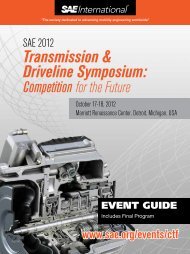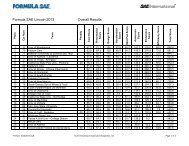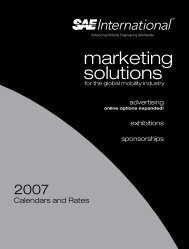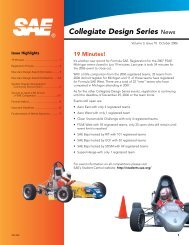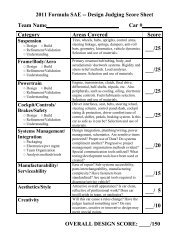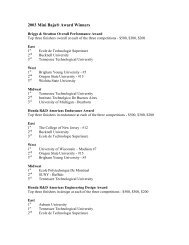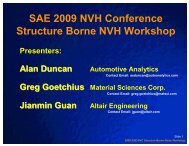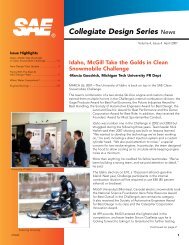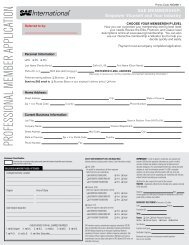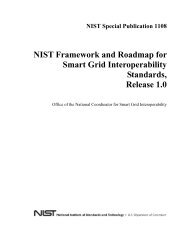The 4T50ME-GI Test Engine at MAN Diesel & Turbo's ... - Sae.org
The 4T50ME-GI Test Engine at MAN Diesel & Turbo's ... - Sae.org
The 4T50ME-GI Test Engine at MAN Diesel & Turbo's ... - Sae.org
You also want an ePaper? Increase the reach of your titles
YUMPU automatically turns print PDFs into web optimized ePapers that Google loves.
<strong>The</strong> <strong>4T50ME</strong>-<strong>GI</strong> <strong>Test</strong> <strong>Engine</strong> <strong>at</strong> <strong>MAN</strong> <strong>Diesel</strong> & Turbo’s<br />
Copenhagen <strong>Test</strong> Centre<br />
1 Introduction<br />
<strong>The</strong> commercial oper<strong>at</strong>ion of two-<br />
stroke, low-speed diesel engines us-<br />
ing n<strong>at</strong>ural gas as a fuel source aboard<br />
ships has been a dream and even an<br />
obsession for decades.<br />
<strong>The</strong> high efficiency and unrivalled relia-<br />
bility of such engines, together with the<br />
widespread availability of an onshore<br />
gas-distribution network since the<br />
1930s, triggered the development and<br />
applic<strong>at</strong>ion of such engines for power<br />
gener<strong>at</strong>ion in the United St<strong>at</strong>es.<br />
At the 1983 CIMAC congress in Paris,<br />
Mitsui <strong>Engine</strong>ering and Shipbuilding re-<br />
launched the concept by proposing a<br />
low-speed K80<strong>GI</strong>DE, also referred to as<br />
a K80MC-<strong>GI</strong>, a low-speed diesel engine<br />
based on the <strong>MAN</strong> B&W K80MC. This<br />
was adapted for high-pressure gas in-<br />
<strong>MAN</strong> B&W <strong>Diesel</strong><br />
jection (<strong>GI</strong>), and was particularly aimed<br />
<strong>at</strong> replacing the r<strong>at</strong>her energy-inefficient<br />
steam turbines used for LNG carrier<br />
propulsion.<br />
At the time, both the gas-vs-fuel price<br />
development, as well as technical and<br />
political reluctance, prevented the idea<br />
from being commercially successful.<br />
However, technically, the concept was<br />
fully proven on the test bed and, com-<br />
mercially, as a prime mover in the Chiba<br />
power plant in Japan.<br />
In more recent times, development has<br />
taken new turns with environmental<br />
consider<strong>at</strong>ions having changed from<br />
being interesting to becoming a neces-<br />
sity. Furthermore, diesel engines have<br />
now entered the propulsion market for<br />
LNG carriers en masse and gas engines<br />
are on the verge of being adopted for<br />
propulsion by other ship types.<br />
Accordingly, <strong>MAN</strong> <strong>Diesel</strong> and Turbo<br />
Denmark took the decision in 2010 to<br />
build a full-scale test and demonstr<strong>at</strong>ion<br />
engine <strong>at</strong> its R&D centre in Copenha-<br />
gen. This intends to clear the way for<br />
the full-scale commercial adoption of<br />
the now electronically-controlled, dual-<br />
fuel, low-speed, two-stroke ME-<strong>GI</strong> die-<br />
sel-engine range.<br />
This paper outlines the building of the<br />
engine, the design and layout of its gas-<br />
supply system and its test programme.<br />
It also discusses the ME-<strong>GI</strong> engine’s<br />
position in the market as one of several<br />
solutions capable of meeting the IMO’s<br />
Tier-III emission regul<strong>at</strong>ions, scheduled<br />
to come in force for newbuildings from<br />
January 1, 2016.<br />
<strong>The</strong> <strong>4T50ME</strong>-<strong>GI</strong> <strong>Test</strong> <strong>Engine</strong> <strong>at</strong> <strong>MAN</strong> <strong>Diesel</strong> & Turbo’s Copenhagen <strong>Test</strong> Centre<br />
6



